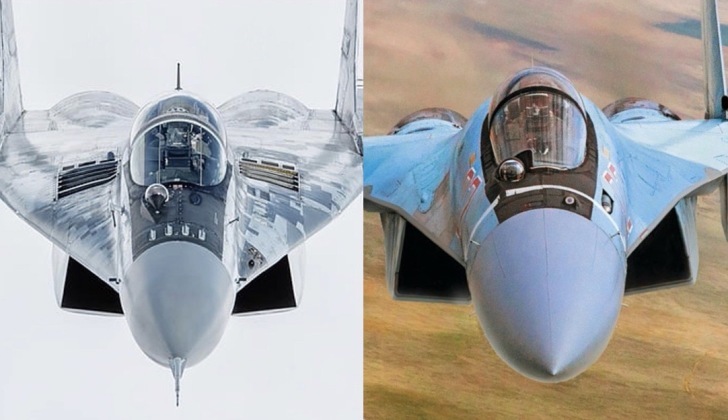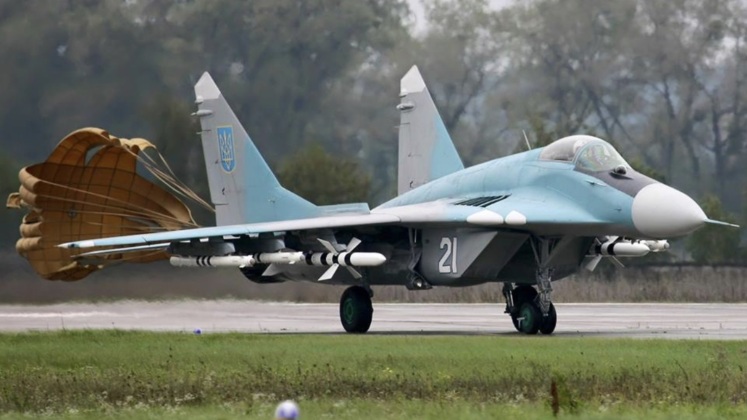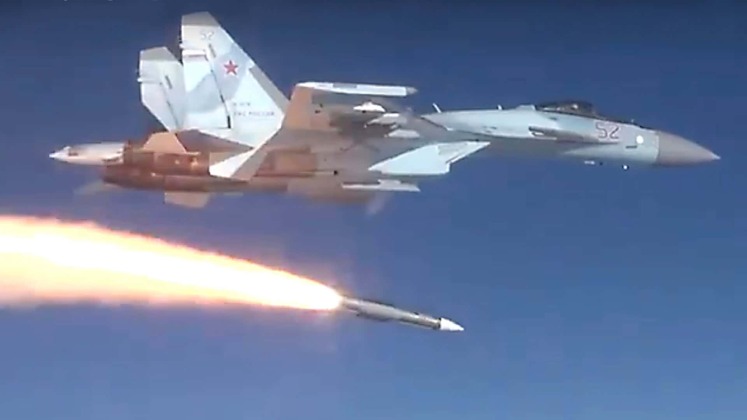Military Watch:
Ten Days of Intense Air Battles Saw Ukraine Lose 17 MiG-29 Fighters: How Many Are Left?
November-1st-2023

MiG-29 (left) and Su-35 Fighters
The month of October saw a significant increase in the intensity of air to air engagements over Ukraine, which according to multiple assessments has been unprecedented since the initial weeks of full scale Russian-Ukrainian hostiles from February 2022.
From October 13-23 Russian forces shot down 17 MiG-29 fighters - a fighter class which Ukraine operated in large numbers when the conflict broke out and has acquired more units of since.
The MiG-29 is one of three fighter classes widely used by Ukrainian forces, alongside the heavier Su-27 air superiority fighter and the Su-24M strike fighter, with all three having been inherited in considerable numbers when the Soviet Union disintegrated. While Su-27s participated in major air battles in the war’s first month in early 2022, numbers have since dwindled while the MiG-29 fleet until October remained relatively large.
This has been a result of both the greater numbers of MiGs Ukraine inherited, as well as the fact that the class was operated by allied states namely Poland and Slovakia which between the donated an estimated 33 of the aircraft - supplementing over 50 that were already in service in Ukraine.

Ukrainian Air Force MiG-29 with R-27 and R-73 Missiles
Although Ukraine has surprised observes with its ability to operate heavyweight Su-27 and Su-24M fighters from makeshift airfields across the country, the MiG-29 is perhaps the best optimised fighter class in the world to such ‘guerrilla airfield’ operations and requires relatively little maintenance and very short airstrips to be able to fly. This has made the fighter class highly prized by clients across the world, from North Korea and India in Asia to Algeria and Sudan in Africa among over a dozen others.

Ukrainian Air Force MiG-29 with R-27 and R-73 Missiles
Although Ukraine has surprised observes with its ability to operate heavyweight Su-27 and Su-24M fighters from makeshift airfields across the country, the MiG-29 is perhaps the best optimised fighter class in the world to such ‘guerrilla airfield’ operations and requires relatively little maintenance and very short airstrips to be able to fly. This has made the fighter class highly prized by clients across the world, from North Korea and India in Asia to Algeria and Sudan in Africa among over a dozen others.
When entering service in 1982 the MiG-29 was unrivalled in its manoeuvrability and benefitted from the ability to target enemy aircraft within visual ranges at very extreme angles using helmet mounted sights - which testing in Germany after the Cold War showed provided an overwhelming advantage over Western aircraft.
Although formidable for its time, Ukraine’s MiG-29s have faced a significant disadvantage in air to air combat when facing the elite of the Russian Air Force - namely MiG-31BM/BSM interceptors, Su-35 air superiority fighters, and even Su-57 stealth fighters which although deployed in limited numbers have been widely reported to have participated in air to air engagements.

Russian Air Force Su-35 Fires R-37M Air to Air Missile
The Russian Air Force has relied particularly heavily on its Su-35s to tackle Ukrainian fighters, with the aircraft continuing to be acquired in large numbers by the Russian Air Force and designed for air to air combat against far more formidable targets than those in Ukraine’s inventory.

Russian Air Force Su-35 Fires R-37M Air to Air Missile
The Russian Air Force has relied particularly heavily on its Su-35s to tackle Ukrainian fighters, with the aircraft continuing to be acquired in large numbers by the Russian Air Force and designed for air to air combat against far more formidable targets than those in Ukraine’s inventory.
Not only is the Su-35 a significantly more modern fighter, using a phased array radar and 21st century avionics against Ukraine’s 1980s combat aircraft, but it is also from a much higher weight range meaning it can carry significantly greater firepower, larger sensors, and heavier longer ranged R-37M air to air missiles which have over triple the range of the R-27s carried by the MiGs.
Although modern MiG-29 variants such as the MiG-29M could pose a challenge to Su-35s in air to air combat, the ageing Soviet-built variants used by Ukraine are effectively obsolete and have not seen their capabilities significantly improved since the 1980s.
The Su-35’s main combat strengths include its extreme manoeuvrability, triple radars and extreme engagement range, which are not currently seen on any Western fighter classes. Having been widely used in combat in Ukraine, the aircraft were first allocated to an aggressor training unit in September 2022 reportedly to impart experience from the Ukrainian theatre.
Deploying from airfields in both Russia and Belarus, the fighter class’ most widely praised engagement was its reported victory over Su-27s over Ukraine’s Zhytomyr region during which four of the older jets were shot down for no Russian losses. The way Su-35s have been deployed indicates it is not unlikely that the bulk of the MiG-29s shot down in recent air to air engagements were engaged by the aircraft.

Ukrainian Air Force MiG-29
Although Ukrainian fighters’ ability to threaten Russian assets in air to air combat has been extremely limited since the war began, its assets have provided valuable contributions by launching strikes on Russian forces - most notably using American AGM-88 and European Storm Shadow and SCALP guided missiles.

Ukrainian Air Force MiG-29
Although Ukrainian fighters’ ability to threaten Russian assets in air to air combat has been extremely limited since the war began, its assets have provided valuable contributions by launching strikes on Russian forces - most notably using American AGM-88 and European Storm Shadow and SCALP guided missiles.
Ukraine has instead relied on ground based air defences as an asymmetric means of engaging superior Russian air power, although as its surface to air missile arsenals have grown increasingly depleted Russian air power’s freedom of action has continued to increase.
Despite continued losses of MiG-29s, with more having been reported since October 23, the Ukrainian Air Force is thought to still deploy over two dozen of the aircraft.
With its Western supporters having largely depleted their stocks of Soviet-compatible equipment, however, the Ukrainian Air Force appears increasingly likely to have to transition to Western fighter classes with Cold War era U.S.-built F-16s having been promised as aid to the country.
The F-16 lacks the MiG-29’s short airfield performance or its high flight performance, but the much larger inventories Western militaries have of the aircraft will allow them to be replenished much more easily.
Based on total Russian claims , Ukraine has lost 180% of its Airforce, but they Keep finding Ukrainian Mig-29s to destroy.
ReplyDeleteSomebody is either lying or they have very bad maths.
It's the same with the pesky Leopards, where Russians have destroyed 150% of them , but they Keep getting resurrected , causing really nasty Russian deaths.
ReplyDeleteWakakaka…
ReplyDeletePlaying numeric acrobatic!
Mfer, DON'T shout for joy. Check the numbers before u fart.
Definitely, Military Watch has better numbers & sources than u - who ONLY trust Western mouthpieces' fabricated numbers.